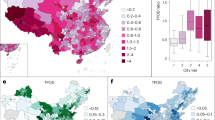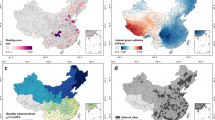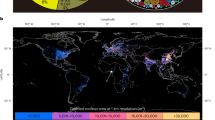Abstract
Urban rooftop agriculture (RA) and photovoltaic power production (RPV) offer sustainable solutions for the food–energy nexus in cities but compete for limited rooftop space. Here we explore the potential benefits (productivity, economic and environmental) and allocation strategy of RA and RPV across 13 million buildings in 124 Chinese cities, considering urban characteristics and regional productivity. We found that RA yields superior economic benefits, while RPV excels in greenhouse gas emission reductions. Prioritizing either RA or RPV can only retain 0–29% of the above benefits brought by the other. However, allocating 61% of the flat rooftop area to RA and all the remaining (including pitched rooftops) to RPV would retain >50% of their potential, meeting 15% (mean, 0.5–99% across cities) of urban vegetable needs and 5% (0.5–27% across cities) of the electricity needs. While the productivity from RA and RPV have significant environmental and socioeconomic benefits, they require considerable water (up to 15% of urban residential water use) and materials (for example, totaling 13 kt silver).
This is a preview of subscription content, access via your institution
Access options
Subscribe to this journal
Receive 12 digital issues and online access to articles
$119.00 per year
only $9.92 per issue
Buy this article
- Purchase on SpringerLink
- Instant access to full article PDF
Prices may be subject to local taxes which are calculated during checkout


Similar content being viewed by others
Data availability
The vectorized urban extent and urban open space is available at https://www.sciencedirect.com/science/article/pii/S0303243421001872 (ref. 34). The GHG emission intensity used in this study is publicly available at http://lca.cityghg.com/. Data for water resource use are available from open-sourced Chinese statistics (https://www.mohurd.gov.cn/gongkai/fdzdgknr/sjfb/tjxx/jstjnj/index.html). The yield for open-air production was taken from the Global Agro-Ecological Zoning database (https://gaez.fao.org/). The SWGDN hourly data from M2T1NXRAD are publicly available at https://disc.gsfc.nasa.gov/datasets/M2T1NXRAD_5.12.4/summary, and 2 m hourly temperature data from ERA5-Land are publicly available at https://cds.climate.copernicus.eu/. Due to copyright issues, other data, such as building outlines and attributes, can only be made available from the authors on request. Source data are provided with this paper.
Code availability
The vectorized and other spatial data, the building-level of potential of vegetable and PV power production and environmental and provisioning performance were processed or quantified with Excel v2021 and Python v3.7 interpreted by ArcGIS Pro. The code for multiobjective optimization was constructed utilizing the open-source Python package pymoo v0.6.1.3 (https://pymoo.org/), which is available at https://github.com/Ruiyang/Urban-rooftops-for-food-and-energy-in-China.
References
Van Dijk, M., Morley, T., Rau, M. L. & Saghai, Y. A meta-analysis of projected global food demand and population at risk of hunger for the period 2010–2050. Nat. Food 2, 494–501 (2021).
Rozowska, A. Universal access to sustainable energy will remain elusive without addressing inequalities. The World Bank https://www.worldbank.org/en/news/press-release/2021/06/07/report-universal-access-to-sustainable-energy-will-remain-elusive-without-addressing-inequalities (2021).
Ramaswami, A., Pandey, B., Li, Q., Das, K. & Nagpure, A. Toward zero-carbon urban transitions with health, climate resilience, and equity co-benefits: assessing nexus linkages. Annu. Rev. Env. Resour. 48, 81–121 (2023).
Li, Z. B., Zhang, Y. & Wang, M. Solar energy projects put food security at risk. Science 381, 740–741 (2023).
Zhang, N. et al. Booming solar energy is encroaching on cropland. Nat. Geosci. 16, 932–934 (2023).
Gu, C. Chinese Urbanization (in Chinese) (Science Press, 2021).
Seto, K. C. & Ramankutty, N. Hidden linkages between urbanization and food systems. Science 352, 943–945 (2016).
Zambrano-Prado, P. et al. Assessment of the food–water–energy nexus suitability of rooftops. A methodological remote sensing approach in an urban Mediterranean area. Sustain. Cities Soc. 75, 103287 (2021).
Garcia, D. J. & You, F. The water–energy–food nexus and process systems engineering: a new focus. Comput. Chem. Eng. 91, 49–67 (2016).
Qiu, J. et al. Scale up urban agriculture to leverage transformative food systems change, advance social–ecological resilience and improve sustainability. Nat. Food 5, 83–92 (2024).
Bai, X. Advance the ecosystem approach in cities. Nature 559, 7–8 (2018).
Clinton, N. et al. A global geospatial ecosystem services estimate of urban agriculture. Earth’s Future 6, 40–60 (2018).
Pradhan, P. et al. Urban food systems: how regionalization can contribute to climate change mitigation. Environ. Sci. Technol. 54, 10551–10560 (2020).
Payen, F. T. et al. How much food can we grow in urban areas? Food production and crop yields of urban agriculture: a meta‐analysis. Earth’s Future 10, e2022EF002748 (2022).
Goldstein, B., Hauschild, M., Fernández, J. & Birkved, M. Testing the environmental performance of urban agriculture as a food supply in northern climates. J. Clean. Prod. 135, 984–994 (2016).
Corcelli, F., Fiorentino, G., Petit-Boix, A., Rieradevall, J. & Gabarrell, X. Transforming rooftops into productive urban spaces in the Mediterranean. An LCA comparison of agri-urban production and photovoltaic energy generation. Resour. Conserv. Recycl. 144, 321–336 (2019).
Chen, S. et al. The potential of photovoltaics to power the belt and road initiative. Joule 3, 1895–1912 (2019).
Zhang, Z. et al. Carbon mitigation potential afforded by rooftop photovoltaic in China. Nat. Commun. 14, 2347 (2023).
Lu, X. et al. Combined solar power and storage as cost-competitive and grid-compatible supply for China’s future carbon-neutral electricity system. Proc. Natl Acad. Sci. USA 118, e2103471118 (2021).
Benis, K., Turan, I., Reinhart, C. & Ferrão, P. Putting rooftops to use—a cost–benefit analysis of food production vs. energy generation under Mediterranean climates. Cities 78, 166–179 (2018).
Toboso‐Chavero, S. et al. Towards productive cities: environmental assessment of the food–energy–water nexus of the urban roof mosaic. J. Ind. Ecol. 23, 767–780 (2019).
Meng, F. et al. The food–water–energy nexus and green roofs in Sao Jose dos Campos, Brazil, and Johannesburg, South Africa. NPJ Urban Sustain. 3, 12 (2023).
Jing, R., Hastings, A. & Guo, M. Sustainable design of urban rooftop food-energy-land nexus. iScience 23, 101743 (2020).
Touil, S., Richa, A., Fizir, M. & Bingwa, B. Shading effect of photovoltaic panels on horticulture crops production: a mini review. Rev. Environ. Sci. Biotechnol. 20, 281–296 (2021).
Bambara, J. & Athienitis, A. K. Energy and economic analysis for the design of greenhouses with semi-transparent photovoltaic cladding. Renew. Energy 131, 1274–1287 (2019).
Mishra, G. K. & Tiwari, G. N. Performance evaluation of 7.2 kWp standalone building integrated semi-transparent photovoltaic thermal system. Renew. Energy 146, 205–222 (2020).
Jing, R. et al. Unlock the hidden potential of urban rooftop agrivoltaics energy-food-nexus. Energy 256, 124626 (2022).
Mamun, M. A. A., Dargusch, P., Wadley, D., Zulkarnain, N. A. & Aziz, A. A. A review of research on agrivoltaic systems. Renew. Sustain. Energy Rev. 161, 112351 (2022).
Cossu, M. et al. Agricultural sustainability estimation of the European photovoltaic greenhouses. Eur. J. Agron. 118, 126074 (2020).
Yano, A. & Cossu, M. Energy sustainable greenhouse crop cultivation using photovoltaic technologies. Renew. Sustain. Energy Rev. 109, 116–137 (2019).
Neupane, D., Kafle, S., Karki, K. R., Kim, D. H. & Pradhan, P. Solar and wind energy potential assessment at provincial level in Nepal: geospatial and economic analysis. Renew. Energy 181, 278–291 (2022).
Lin, J. et al. Relative optimization potential: a novel perspective to address trade-off challenges in urban energy system planning. Appl. Energy 304, 117741 (2021).
Li, S. et al. Integrated agricultural practices and engineering technologies enhance synergies of food-energy-water systems in corn belt watersheds. Environ. Sci. Technol. 57, 9194–9203 (2023).
Xu, Z. et al. Mapping hierarchical urban boundaries for global urban settlements. Int. J. Appl. Earth Obs. Geoinf. 103, 102480 (2021).
Regional Power Grid Baseline Emission Factors of 2019 Annual Carbon Mitigation Project in China (in Chinese) (Ministry of Ecology and Environment of the People’s Republic of China, 2020).
China water resources bulletin. Ministry of Water Resources of the People’s Republic of China http://www.mwr.gov.cn/zzsc/tjgb/szygb/2022/mobile/index.html (2022).
Meldrum, J., Nettles-Anderson, S., Heath, G. & Macknick, J. Life cycle water use for electricity generation: a review and harmonization of literature estimates. Environ. Res. Lett. 8, 015031 (2013).
Jia, X., Zhou, C., Tang, Y. & Wang, W. Life cycle assessment on PERC solar modules. Sol. Energy Mater. Sol. Cells 227, 111112 (2021).
Mu, D. & Zhang, Y. Potential of vegetable production and photovoltaic power generation in rooftop greenhouse: taking Tianjin city as an example (in Chinese). Build. Energy Effic. 48, 83–90+125 (2020).
Bai, Z. et al. A food system revolution for China in the post-pandemic world. Resour. Environ. Sustain. 2, 100013 (2020).
Pradhan, P. et al. A systematic review highlights that there are multiple benefits of urban agriculture besides food. Glob. Food Sec. 38, 100700 (2023).
Zurek, M., Hebinck, A. & Selomane, O. Climate change and the urgency to transform food systems. Science 376, 1416–1421 (2022).
Chen, P. et al. The heterogeneous role of energy policies in the energy transition of Asia–Pacific emerging economies. Nat. Energy 7, 588–596 (2022).
Rufí-Salís, M. et al. Recirculating water and nutrients in urban agriculture: an opportunity towards environmental sustainability and water use efficiency? J. Clean. Prod. 261, 121213 (2020).
De Zeeuw, H. et al. in Rooftop Urban Agriculture (eds. Orsini, F. et al.) 309–382 (Springer, 2017).
Fang, L., Lv, J. & Huo, Y. Study of operating characteristics of rooftop distributed photovoltaic grid-connected generation system (in Chinese). J. Tianjin Chengjian Univ. 25, 284–289 (2019).
‘Jinan City greening regulations’ implementation rules (in Chinese). Jinan Municipal People’s Government http://www.jinan.gov.cn/art/2023/9/13/art_85285_307.html (2023).
Notice of Dongguan Municipal People’s Government Office on issuing the implementation opinions on promoting the construction of Sponge City (in Chinese). Dongguan Municipal People’s Government http://www.dg.gov.cn/zwgk/zfxxgkml/szfbgs/zcwj/qtwj/content/post_591216.html (2017).
Financing Urban Adaptation to Climate Change (European Environment Agency, 2017).
Sunter, D. A., Castellanos, S. & Kammen, D. M. Disparities in rooftop photovoltaics deployment in the United States by race and ethnicity. Nat. Sustain. 2, 71–76 (2019).
Beijing Roof Greening Specifications (Beijing City Bureau of Landscape and Greening, 2016).
Shanghai Greening Regulations Amendment (Shanghai City Administration of Law Enforcement for Urban Management, 2018).
Technical Regulations Planted Roof Engineering (Ministry of Housing and Urban–Rural Development of China, 2013).
Proksch, G. & Ianchenko, A. in Urban and Regional Agriculture (ed. Droege, P.) 503–532 (Elsevier, 2023).
Dorr, E., Goldstein, B., Horvath, A., Aubry, C. & Gabrielle, B. Environmental impacts and resource use of urban agriculture: a systematic review and meta-analysis. Environ. Res. Lett. 16, 093002 (2021).
Masters, G. M. Renewable and Efficient Electric Power Systems (Wiley, 2004).
Qiu, T. et al. Potential assessment of photovoltaic power generation in China. Renew. Sustain. Energy Rev. 154, 111900 (2022).
Global Modeling and Assimilation Office & Pawson, S. MERRA-2 tavg1_2d_rad_Nx: 2d,1-hourly, time-averaged, single-level, assimilation, radiation diagnostics V5.12.4. NASA Goddard Earth Sciences Data and Information Services Center https://doi.org/10.5067/Q9QMY5PBNV1T (2015).
Muñoz Sabater, J. ERA5-Land hourly data from 1950 to present. Copernicus Climate Change Service https://doi.org/10.24381/CDS.E2161BAC (2019).
Long, Z., Li, H., Bu, X., Ma, W. & Zhao, L. Solar radiation on vertical surfaces for building application in different climate zones across China. J. Renew. Sustain. Energy 5, 021418 (2013).
Qi, Y., Fang, S. & Zhou, W. Variation and spatial distribution of surface solar radiation in China over recent 50 years (in Chinese). Acta Ecol. Sin. 34, 7444–7453 (2014).
Tang, W., Yang, K., Qin, J., Li, X. & Niu, X. A 16-year dataset (2000–2015) of high-resolution (3 h, 10 km) global surface solar radiation. Earth Syst. Sci. Data 11, 1905–1915 (2019).
Ye, J. Y., Reindl, T., Aberle, A. G. & Walsh, T. M. Performance degradation of various PV module technologies in tropical Singapore. IEEE J. Photovolt. 4, 1288–1294 (2014).
Luo, W. et al. A comparative life-cycle assessment of photovoltaic electricity generation in Singapore by multicrystalline silicon technologies. Sol. Energy Mater. Sol. Cells 174, 157–162 (2018).
Fath, K. et al. A method for predicting the economic potential of (building-integrated) photovoltaics in urban areas based on hourly radiance simulations. Sol. Energy 116, 357–370 (2015).
Lukač, N., Seme, S., Dežan, K., Žalik, B. & Štumberger, G. Economic and environmental assessment of rooftops regarding suitability for photovoltaic systems installation based on remote sensing data. Energy 107, 854–865 (2016).
Mansouri Kouhestani, F. et al. Evaluating solar energy technical and economic potential on rooftops in an urban setting: the city of Lethbridge, Canada. Int. J. Energy Environ. Eng. 10, 13–32 (2019).
Peña, A., Rovira-Val, M. R. & Mendoza, J. M. F. Life cycle cost analysis of tomato production in innovative urban agriculture systems. J. Clean. Prod. 367, 133037 (2022).
Wu, Z. Three-Dimensional Numerical Simulation of Dust Deposition on the Surface of Photovoltaic Modules (in Chinese). MSc thesis, Nanchang Univ. (2022).
Zhang, Z. et al. Cleaning effect analysis and cleaning cycle prediction of PV modules in PV power stations (in Chinese). Sol. Energy 12, 53–61 (2022).
Lin, J. Research on Investment Estimation of Roof Photovoltaic Power Station Project Based on Life Cycle Theory (in Chinese). MSc thesis, Zhejiang Univ. (2023).
Mangiante, M. J. et al. Economic and technical assessment of rooftop solar photovoltaic potential in Brownsville, Texas, USA. Comput. Environ. Urban Syst. 80, 101450 (2020).
China Products Carbon Footprint Factors Database (China City Greenhouse Gas Working Group, 2022).
Li, Y. Life Cycle Assessment of Crystalline Silicon Modules in China (in Chinese). MSc thesis, Shanghai Jiao Tong Univ. (2015).
Cheng, D. Study on Environmental Benefits of Lithium-Ion Batteries in Life Cycle Based on Green Development Concept (in Chinese). MSc thesis, Guangdong Univ. Technology (2019).
Jia, X., Lv, F., Li, P. & Wang, W. Life-cycle assessment of p-type multi-Si back surface field (BSF) solar module in China of 2019. Sol. Energy 196, 207–216 (2020).
China Energy Statistical Yearbook (in Chinese) (National Bureau of statistics of the People’s Republic of China, 2020).
Liang, J. Environmental Effects Investigating for the Grid-Connected BAPV (in Chinese). PhD thesis, Tianjin Univ. (2012).
Blank, J. & Deb, K. Pymoo: multi-objective optimization in Python. IEEE Access 8, 89497–89509 (2020).
China PV industry development roadmap (in Chinese). China Photovoltaic Industry Association http://www.chinapv.org.cn/road_map/1137.html (2023).
Zhao, B., Zhang, X. & Hong, B. Energy penetration of large-scale distributed photovoltaic sources integrated into smart distribution network (in Chinese). Electr. Power Autom. Equip. 32, 95–100 (2012).
Zhao, B., Xiao, C., Xu, C., Zhang, X. & Zhou, J. Pentration based accommodation capacity analysis on distributed photovoltaic connection in regional distribution network (in Chinese). Autom. Electr. Power Syst. 41, 105–111 (2017).
Zhuo, Z., Zhang, N., Xie, X., Li, H. & Kang, C. Key technologies and developing challenges of power system with high proportion of renewable energy (in Chinese). Autom. Electr. Power Syst. 45, 171–191 (2021).
Specht, K. et al. Urban agriculture of the future: an overview of sustainability aspects of food production in and on buildings. Agric. Hum. Values 31, 33–51 (2014).
Lang, T., Gloerfeld, E. & Girod, B. Don’t just follow the sun—a global assessment of economic performance for residential building photovoltaics. Renew. Sustain. Energy Rev. 42, 932–951 (2015).
Acknowledgements
This study was financially supported by National Natural Science Foundation of China (52100214), LIESMARS Special Research Funding and the Start-up Funding of Wuhan University awarded to Y.H. P.P. acknowledges funding from the European Research Council for the BeyondSDG project (project number 101077492) and the Food System Economics Commission, funded by the IKEA Foundation (grant agreement no. G-2009-01682).
Author information
Authors and Affiliations
Contributions
Y.H., R.Y. and C.X. conceived the study. R.Y., Y.H., C.X., P.P. and H.Z. developed the methodology. R.Y., Y.H. and C.X. constructed the datasets and drafted the manuscript. L.J., X.B., Z.W., P.P., S.C. and Y.-G.Z. analyzed the results and supervised the study. All authors contributed to the manuscript.
Corresponding authors
Ethics declarations
Competing interests
The authors declare no competing interests.
Peer review
Peer review information
Nature Cities thanks Sebastian Zainali, Perla Zambrano-Prado and the other, anonymous, reviewer(s) for their contribution to the peer review of this work.
Additional information
Publisher’s note Springer Nature remains neutral with regard to jurisdictional claims in published maps and institutional affiliations.
Supplementary information
Supplementary Information
Supplementary Notes 1–6, Tables 1–9, Figs. 1–8 and discussions.
Source data
Source Data Fig. 1
Potential benefits in 124 cities if all productive rooftop areas were applied in either RA or RPV production.
Source Data Fig. 2
Optimal allocations of RA or RPV.
Rights and permissions
Springer Nature or its licensor (e.g. a society or other partner) holds exclusive rights to this article under a publishing agreement with the author(s) or other rightsholder(s); author self-archiving of the accepted manuscript version of this article is solely governed by the terms of such publishing agreement and applicable law.
About this article
Cite this article
Yang, R., Xu, C., Zhang, H. et al. Urban rooftops for food and energy in China. Nat Cities 1, 741–750 (2024). https://doi.org/10.1038/s44284-024-00127-4
Received:
Accepted:
Published:
Issue date:
DOI: https://doi.org/10.1038/s44284-024-00127-4
This article is cited by
-
Underlying rules of evolutionary urban systems in Africa
Nature Cities (2025)



